Hello,
Welcome to today’s edition of Kitchen Projects. Thank you so much for being here.
Today, I am thrilled to share a newsletter that is coming at a very fateful and totally unintentional moment in our time: ALL ABOUT COCONUT!
I know, the timing is crazy, and no, this is not a newsletter about Kamala Harris. Instead, it’s a deep dive into what on earth is going on in that coconut aisle. From decoding all the products out there to how to make your own milk and a bunch of recipes (partly couldn’t help myself, partly wanted to be DONE with coconuts for a while), this is my first—but it won't be my last—foray up the coconut tree.
Over on KP+, I’m sharing my recipes for Ultimate Coconut Cake, featuring coconut sponge, green tea syrup, coconut whipped custard, passionfruit curd, and rum vanilla buttercream, Toasted Coconut Custard Tart and for dreamy Drømmekage Semifreddo, aka salty sticky brown sugar coconut-inspired layered semifreddo.
What's KP+? Well, it's the level-up version of this newsletter. By joining KP+, you will support the writing and research that goes into the newsletter (including the commissioning - and fair payment - of all the writers), join a growing community, access extra content (inc., the entire archive with 300+ recipes) and more. Subscribing is easy and only costs £6 per month or just £50 per year (equivalent to £4.10 per month). Why not give it a go? Come and join the gang!
Love,
Nicola
I think I just fell out of a coconut tree
When I first mentioned coconuts on my Instagram story a few weeks ago, I got three main reactions: Love, Hate and Confusion. And to be honest, I had no idea there were so many ways to eat a single ingredient - coconut has got to be one of the most proliferated ingredients out there; What I thought would be a 3-4 day project has turned into a three-week search for understanding - and, like the haunted coconut that simply wouldn’t crack (IYKYK - insta stories were wild last week), I don’t know if I’ve even scratched the surface.
Still, I wanted to share everything I’ve learned to this point, along with a series of recipes to get you going, whether you’re a coconut sceptic or lover. Using a whole host of coconut products, you can mix and match these recipes until you are completely coco loco, like me: Danish Dream Cake Inspired Semi-Freddo, Toasted Coconut Custard Tart, Ultimate Passion & Coconut Layer Cake, and a Simple Buttery Coconut Bundt with Coconut Whipped Ganache and Peaches.
What IS coconut?
Crack open a coconut, and you’ll identify three main parts: a hard outer shell, white firm ‘flesh’ or ‘meat’, and lightly sweet water. (And btw, if you want tips on opening a coconut - I am NOT the person to ask. IYKYK; I suggest Youtube tutorials!)
Like the peanut and the tiger nut, coconut is another ‘nut’ that isn’t a ‘nut’ at all. It is, in fact, a ‘drupe’. No, I wasn’t familiar with that word either. It is, in fact, the botanical word for ‘stonefruit’, meaning technically, coconuts are considered to be in the same family as peaches, plums and nectarines. But look at a coconut's unique structure and nutritional value, and you’ll find it’s miles away from your average stonefruit.
If, like me, you are wondering, ‘If coconut is a stone fruit… where is the stone?’ Then yeah, I agree; it’s very confusing. To qualify as a drupe, a fruit needs three things: an exocarp (outer layer), a mesocarp (middle layer), and the endocarp (a tough layer that surrounds a seed). You’ll have no trouble identifying these three parts in a peach, but a coconut? Not so simple.
You see, the coconut is not your average drupe or stone fruit. It’s actually a ‘fibrous, one-seeded drupe’ or a ‘dry drupe’, which, though doesn’t sound very glam, imbues it with special powers. And unlike its fleshy siblings, with lovable, flavourful mesocarps, we never even get to meet the coconut’s two outermost layers - they are discarded before being sold. The coconuts we are used to seeing? That’s *just* the endocarp - it’s the equivalent of going into a shop and just finding peach pits for sale - meaning the coconut flesh and water, the bits we eat, is actually the ‘seed’ of the fruit.
With these unique features, the coconut has emerged as a preeminent source of both flavour and commerce. The two outer layers, known collectively as the husk, are used in a variety of ways - from producing coir fibres used for ropes and house building to being used as fuel (a charcoal source) - while the edible seed is processed in a baffling amount of ways. According to this piece, it’s set to be a $31 billion industry by 2026. Eight of these billions, at the present time, are thanks to the desiccated coconut industry. And so begins our exploration into the rather expansive and bamboozling world of coconut products. From milks to creams, flakes to oils, and flours to milk powders. The high-fat content (mostly saturated!) of the coconut makes way for fruitful substitutions in cakes and custards.
Like playing a game of whack-a-mole, every time I thought I’d found every single coconut product out there, I was notified of a new one! But if I had to pick, the most ubiquitous coconut product is almost certainly coconut milk.
While the EU dairy lobby has been successful in preventing the use of ‘milk’ for products made from oats, tofu and soya, the US has not. But as these debates raged hotly, coconuts were left unscathed - coconut ‘milk’, ‘butter beans’, ‘peanut butter’, ‘custard creams’ and ‘cream crackers’ were given an exception. It’s a muddled, complicated definition, but as I've learned this week, coconut milk is a muddled, complicated thing. Crack open a coconut, and, as I'm sure you know, opaque white coconut milk will not flow out. The milk is simply coconut flesh blended with water and passed through a fine sieve or muslin as a smooth liquid.
Here is a list of all the coconut products I have encountered or am aware of during the research of this newsletter:
It’s a big coconutty world out there! So how do we know what to buy? Let’s focus on one topic: Coconut Milk.
Hands up if you’ve ever been personally victimised by coconut milk
Picking a coconut milk feels like a minefield - go to any shop and you are greeted with an array of brands. It can be overwhelming. But remember, all coconut milk is coconut flesh combined with water, then passed to create a milky liquid.
So, when picking coconut milk, you need to consider three categories: flavour, Fat Content, and extras.
I picked up 6 options to compare - all of these are sold as coconut milk but vary wildly.
You can find the fat content by checking the nutritional table - this is important to know when you’re baking as introducing fat into a cake mixture, a ganache, or a custard is going to be one of your key data points in how it will affect your final product.
Most advice would have you pick coconut milk with the highest coconut content. But maybe you’re surprised to hear that product labelling is intentionally confusing? Probably not. But the ingredients lists of these products are misleading - some with higher percentages like Coconut Merchant, which lists “78% Extract” has a fat content in line with a Coconut Milk like Biona Organic, which has “50% coconut”. So, extract does not equal coconut! That means even though the ingredients and amount of coconut are expressed differently, most coconut milks sold come in at similar fat contents.
So then, the real deciding factor is texture and flavour. Unlike their Western counterparts, I found the coconut milk brands like AROY-D and Chaokoh that you can find in specialist supermarket aisles and Asian supermarkets to be the most homogenous, smooth and strong flavoured.
It must be noted, too, there’s a dark side to coconut milk; Many producers use monkeys, with cruel treatment, as labour. This is especially prevalent in Thailand, the third largest coconut exporter in the world, leading many companies to stop importing or using coconut milk farmed here. As always, educate yourself on the farming practices and decide what you are comfortable supporting - I can’t make that decision for you!
Making your own
Your other option, of course, is to blend your own coconut milk. When it comes to baking or balancing recipes, I like to have maximum control over the ingredients—if it's going into a cake, I want to know how much fat and water it’s providing so I can adjust the other ingredients. Remember, making your own recipes is nothing more than a balancing act.
You have two options - take a raw coconut (or fresh frozen shreds), crack it open, blend the flesh into a fine shred, blend with water and pass through fine muslin - the first pressing of coconut milk will be the richest. Repeat with the remainder for less rich coconut milk. This is quite labour intensive, so you’ve other options: Creamed coconut is a concentrated block of coconut flesh that has been blended and compressed - it is ⅔ flesh and ½ coconut oils, which separate over time. Unlike coconut milk, I could not find a creamed coconut with any ingredients other than 100% coconut.
As a result, you’ll be able to make your own coconut milk without any extra ingredients and have a higher degree of control on the ratios, meaning you can make the product you want! It’s advisable to cut the block longways, from north to south, to ensure an even mixture of oil and compressed flesh.
With a fat content of about 65%, a 2:1 ratio of water to creamed coconut gives you coconut milk with around 20% fat, while mixing 1:1 creamed coconut and water will give you a liquid with about 30% fat.
The only thing to consider is the texture - commercial coconut creams and milks have been highly processed and passed through a number of fine mills to ensure complete smoothness and the ‘cream’ will have more body. Creamed coconut, which I think is relatively less processed, has a grainy - not unpleasant! - texture. Passing several times or through a muslin is advisable.
Coconut Milk Powder does make coconut milk instantly and can be added directly to sauces and curries to add texture and flavour. It is not as thick as the creamed coconut and, as I understand it, is made by dehydrating coconut milk. As before, it’s hard to know exactly what ratio of coconut milk has been dehydrated, but it’s a delicious, flavourful product. To be honest, it's expensive and highly processed.
Hacking coconut milk: TOASTED!
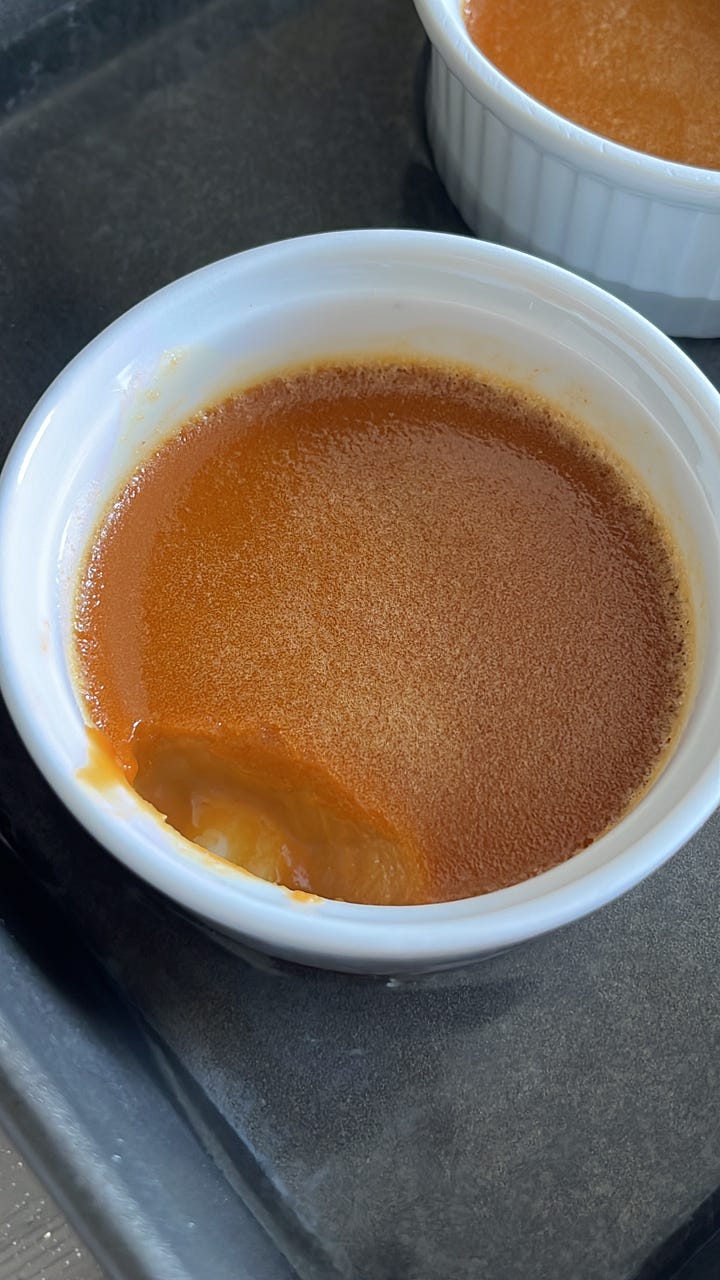

I love toasted coconut as a flavour and have long been a fan of using it in infusions (see here), so I was THRILLED to discover a way to achieve these flavours.
One of the best things I discovered this week came to me when I was mixing up coconut milk. If we can turn creamed coconut into coconut milk… Does that mean we can turn toasted coconut into toasted coconut milk? The answer is yes, yes, we can. By toasting creamed coconut - or coconut milk powder - in the oven before mixing with water, we can create a whole new category of coconut milk(s). I have become my own whack-a-mole-coconut-product-maker! I immediately made it into a custard and, then, a custard tart. All. Sooooo. Good!
You can also control the degree of toastiness - a light pale brown for a je ne sais quois touch, or a darker colour for nuttiness. The powder can be added directly into cookies, cakes etc. - just think anywhere you’d add toasted milk powder, or malt powder, you can swap it for toasted coconut powder. Find the technique and recipe on KP+:
Even though I love this technique, it’s still worth knowing how to use a classic infusion so I’ll show you this method in the drømmekage semifreddo.
What about Cream?
Creamed coconut is not to be confused with ‘coconut cream’. I know. I feel insane, too. Coconut cream refers to the thicker, richer portion of coconut milk that sits on top of the tin when you open it.
If you pick up a can of ‘coconut cream,’ you’re getting a higher proportion of coconut with less water. If you can’t find coconut cream or just want to use that luscious fatty part, you can easily scoop it off the top of any old tin of coconut milk. Other than the aforementioned Thai brands, almost all coconut milk comes completely separated into layers.
If you want to learn more about coconut cream, look no further than Brian Levy’s excellent column ‘All About Whipped (not) Cream’ as he goes on a journey to discover what makes cream whipped, with a lot of good coconut information in the way. And remember, you can make your own - mixing 1:1 creamed coconut and water will give you a liquid with about 30% fat, though you are welcome to play around with this ratio to get the desired consistency.
Baking with Coconut
I am not the source to speak to about coconut milk in savoury cooking, but I’ll admit—I was pretty unmoved by coconut for a long time. Bounty bars were always the last to be eaten in the tin of celebrations at Christmas, and I’d put them in the truffle oil camp—too scene-stealing and not playing well with others. But over time, I’ve seen the error of my ways.
Now I see coconut, and I get excited: From the desiccated flakes on a Lamington to classic Southern USA Coconut Cakes, the famous White Chocolate Coconut Bundt that Tom Cruise sends around the world every Christmas, and sticky Danish drømmekage “Dream Cake,” I’m all in.


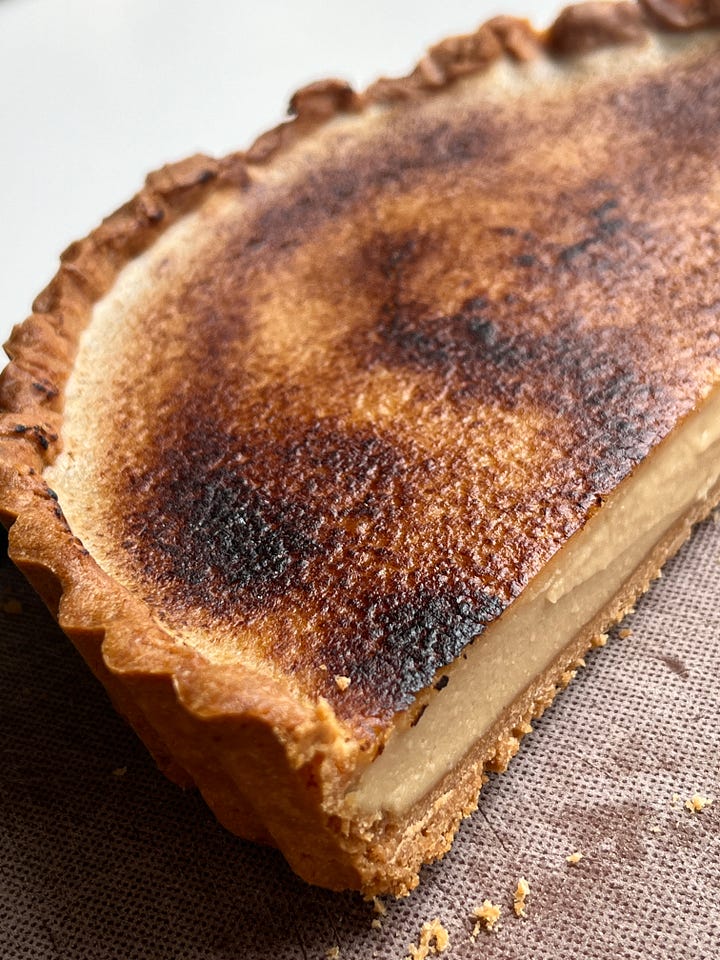

In my opinion, coconut's flavour can be expressed in two main ways: floral and mildly sweet or rich, aromatic and nutty. The difference? Toasting it. When direct heat is applied, coconut undergoes the Maillard reaction, creating complex flavour compounds that could turn even the most ardent coconut hater into a fan. I've got recipes with celebrate both routes.
Head-to-head bake tests
SO, now we know all the options at our disposal, how do we get coconut flavours into our cakes? I made up a batch of cakes and added coconut in various ways to see how they measured up.
The flavour of these bakes ranged from non-existent to subtle to decent to ‘commendable’ (that really was the most extreme compliment I gave. Let’s go deeper:
Not pictured: Coconut flour and extract. I tried both of these - coconut flour is very dry if used in conjunction with regular flour, and the flavour was minimal. I think it is a good idea to use a portion of coconut flour or blitzed desiccated coconut as a non-gluten-forming solid to add to cakes, but I am not strong enough in gf baking to understand the best way to deploy it. The extract is successful, but I’m not sure - even if it is a natural flavouring, why does the extract always taste so dang fake?
Clearly there are a few winners - creamed coconut should be used, but deployed with care as it is very heavy and dense, though delicious, when added to a cake. The concentrated flavour of the oil along with dessicated coconut gave me the best results, plus tenderness from the coconut milk (the holy trinity I use in my buttery coconut cake, below) I welcome you to test your own combinations, but be aware of the trade-offs - there are, unfortunately, many. Not all roads paved with coconut lead to flavour.
Alright, shall we bake?
I’m not out here to get you to buy as many coconut products as possible - in fact, after these few weeks, I'll be minimising my coconut store to just a few products! But since I had so much in stock, I had fun making as many recipes as possible using the whole family. You can mix and match the coconut sources I use in these recipes, too, depending on what you have in stock. Here’s the line-up with recipes from the archive, too:
Level 1 Coconut: Coconut Curious
Coconut Whipped Cream by Brian Levy
Level 2 Coconut: I like (coco)nuts and I cannot lie
Choconut Tart from SIFT, also here on the newsletter
Buttery coconut cake with sour cream whip and peaches (below!)
Level 3 Coconuts: Fully Coco Loco
Helen Goh’s Coconut Pandan Chiffon Cake
Not on KP, but my friend Claire’s Coconut Jam/Spread is SO delicious
Buttery coconut cake with sour cream whip and peaches
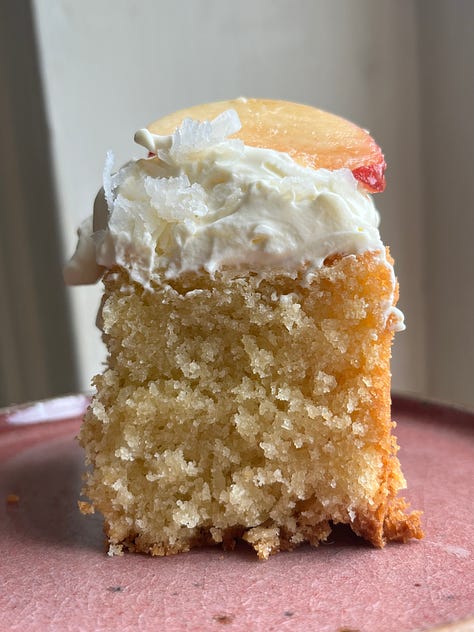

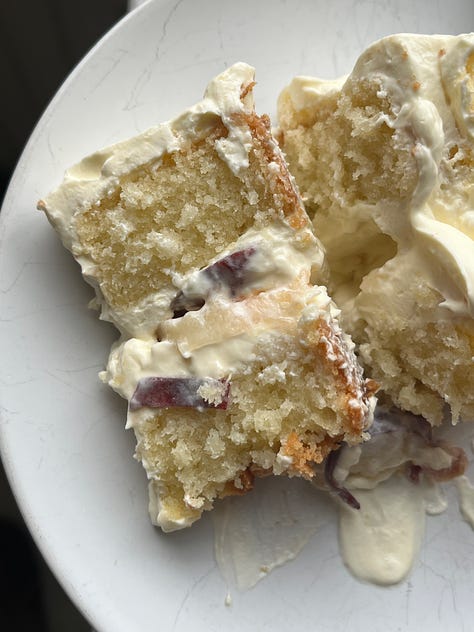
This is the most classic, fluffy coconut cake recipe and my homage to the American coconut cakes I see online. It has a slightly sticky, coconut-infused crumb and can be thrown together in minutes. It uses butter and coconut oil as the base, along with desiccated coconut and coconut milk to add flavour, moisture, and texture. You could serve this with anything, but tangy sour cream whip and peaches are delicious. It’s also quite fun to halve the cooled bundt and serve it as a two-layer cake.
The Recipe
Serves 4-5
This recipe makes one small ish 6-inch cake. I used this tin as couldn’t find my bundt pan! You can certainly ccale up the recipe to fit your own tin; A 6 inch without a hole in the middle might be a little small. You could easily times this recipe by 1.5 for a thick single laye 6 inch cake, or a thin, elegant single layer 8-inch cake.
Ingredients
Cake
50g Butter
50g Coconut Oil
120g Caster Sugar
75g Whole Egg (or One Whole Egg + 1 Yolk)
120g Plain Flour
1 ¼ tsp Baking Powder
40g Desiccated Coconut
¼ tsp Flaky Salt
150g Coconut Milk
Whipped Sour Cream
40g Sour Cream*
20g Caster Sugar
160g Whipped Cream
*Replace this with coconut milk or coconut cream to make this coconut-flavoured!
Plus 2-3 good ripe peaches to serve, and, if you have it, sweetened bakers coconut (DIY recipe coming soon!)
Method
Pre-heat oven to 160c fan.
Cream coconut oil, butter, and sugar together until pale and creamy. The coconut oil will likely melt, so this mixture won’t look fluffy. Add the egg(s) and mix until well combined, scraping down the side of the bowl as needed. Next, add the dry ingredients—flour, baking powder, and desiccated coconut and mix on a low speed while drizzling the coconut milk down the side of the bowl. It should combine into a pourable batter.
Pour into your tin and spread out evenly. I used a small 6-inch bundt pan, greased but not lined, but any 6-inch cake tin will do.
Bake for 22-25 minutes or until a skewer comes out with just a few moist crumbs. Leave to cool completely.
Once cooled, whip the ingredients for the cream together and spoon onto the cake and top with peaches, OR double the cream recipe, split the cake in half and fill it cream and sliced peaches. Place the other half on top then cover in cream.
Store any leftovers in the fridge for 2-3 days, but try and serve close to room temp as the texture of the cake is not at its best when cold.





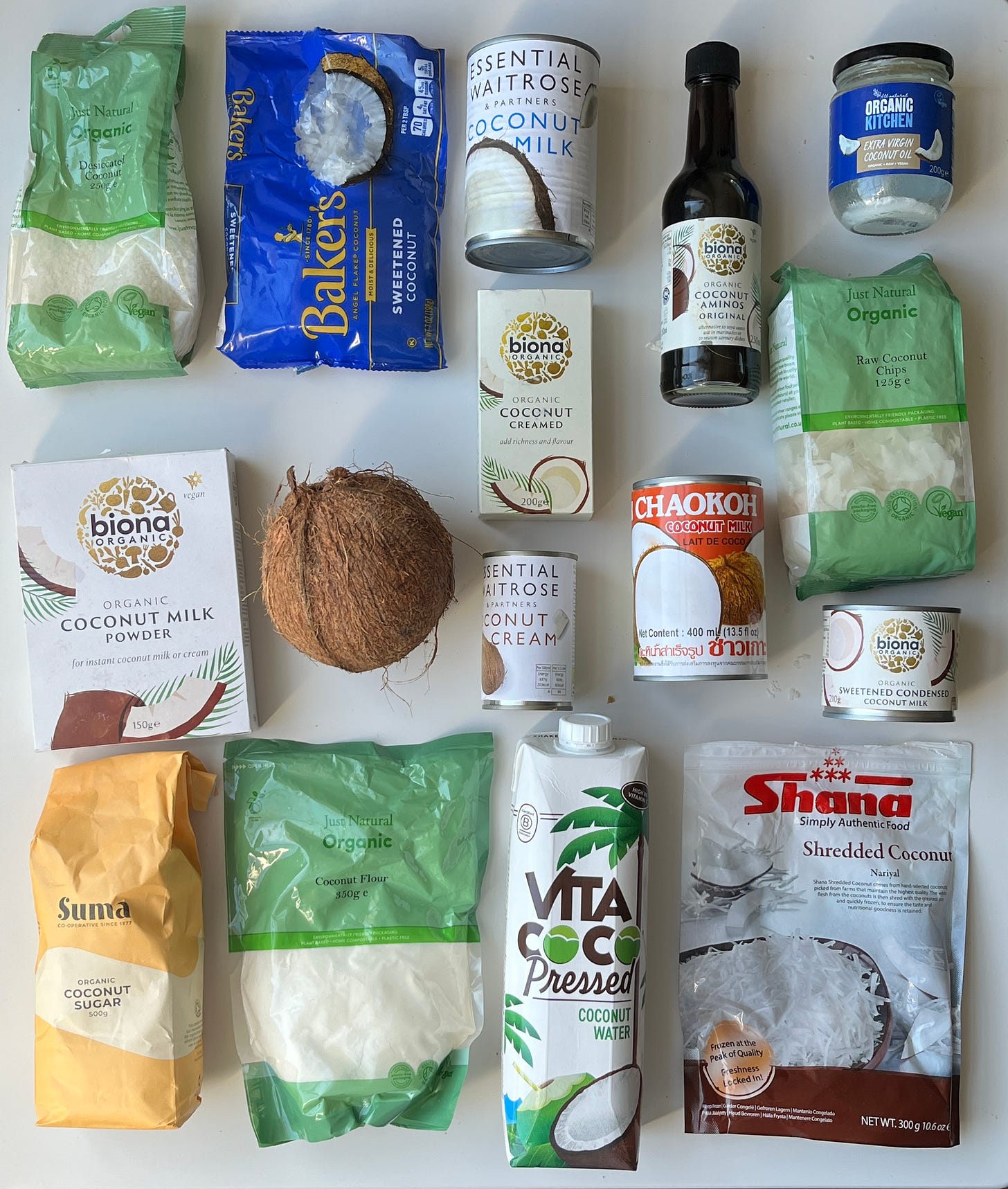



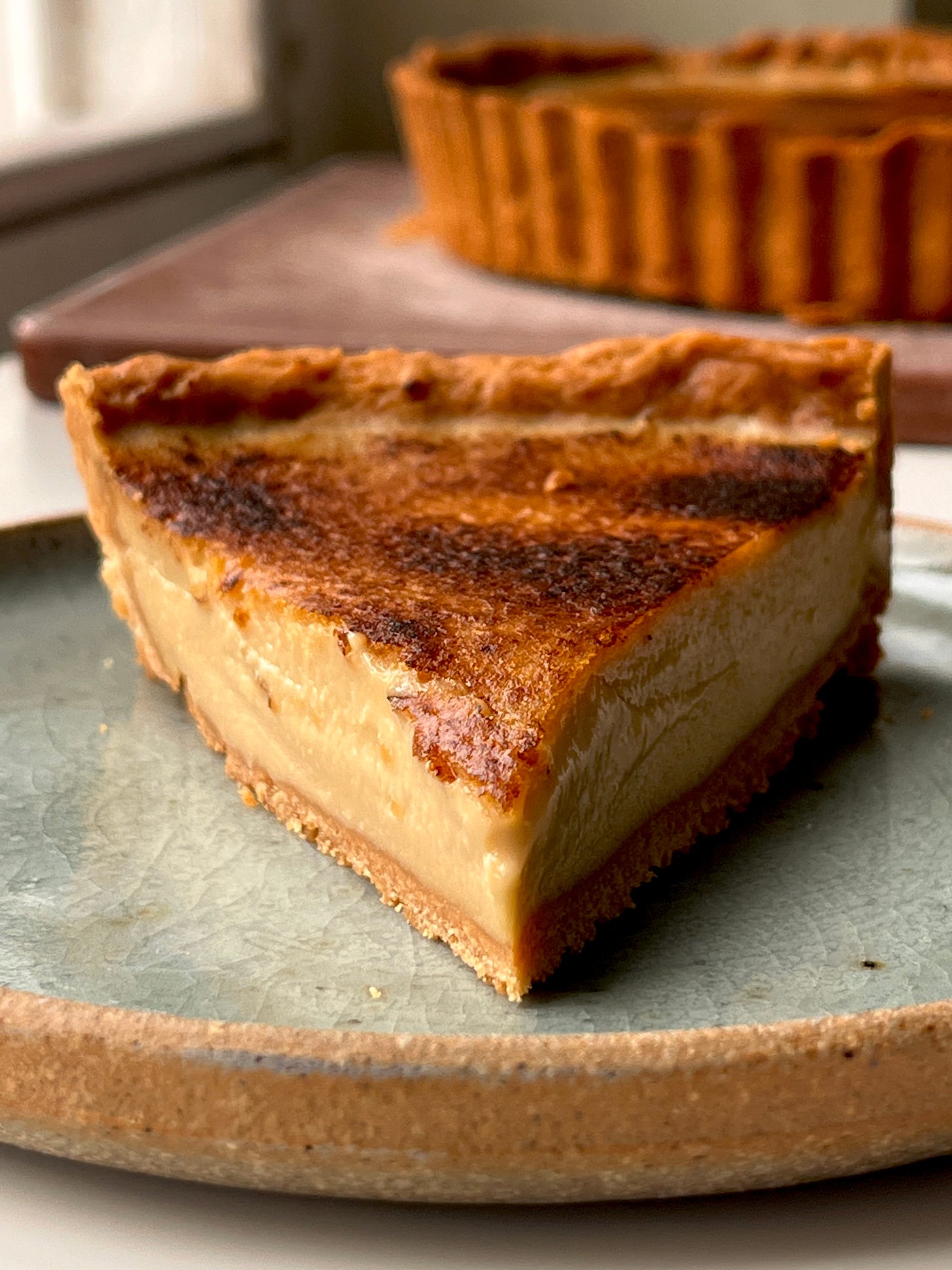

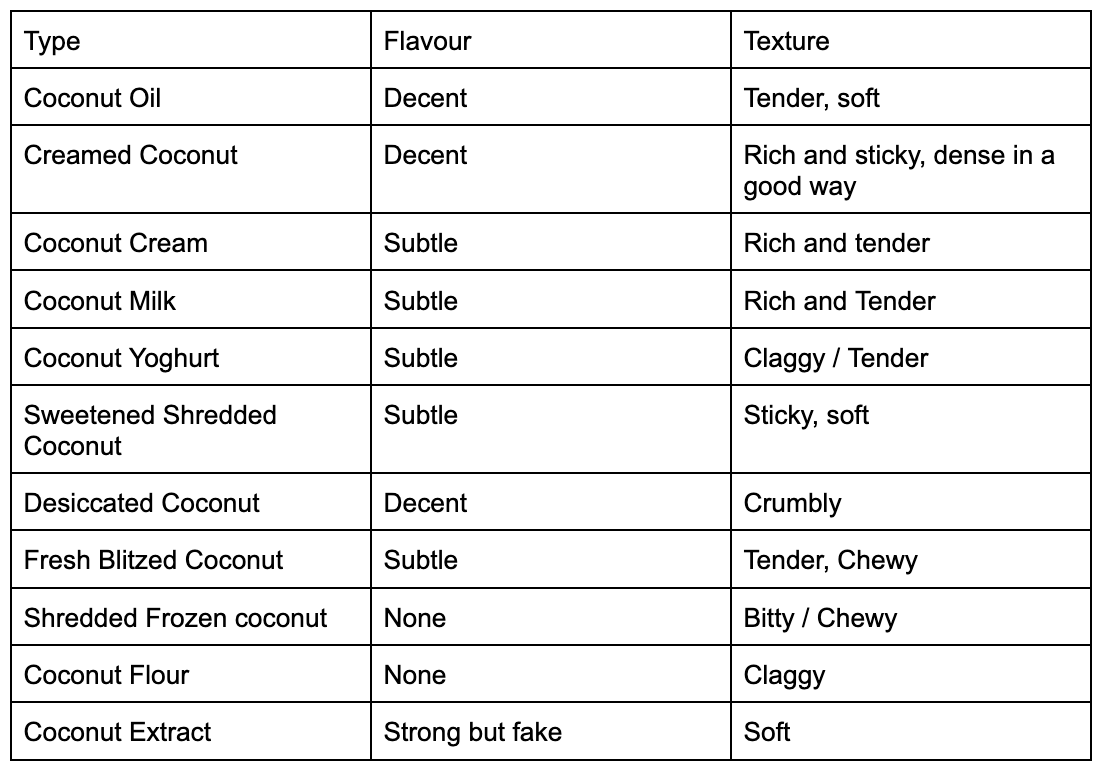

I LOVE COCONUTS! And I love KP!
To add to the complications: in Australia, shredded coconut is a dried product, like desiccated, but with much longer, thicker strands. Mostly used in granola and cake decorating!
I'd love a dive into Angel Flake - it's so expensive and hard to come by in the UK and I am not entirely sure all the ingredients are things I want to eat, but I have never found a completely satisfactory DIY approach.